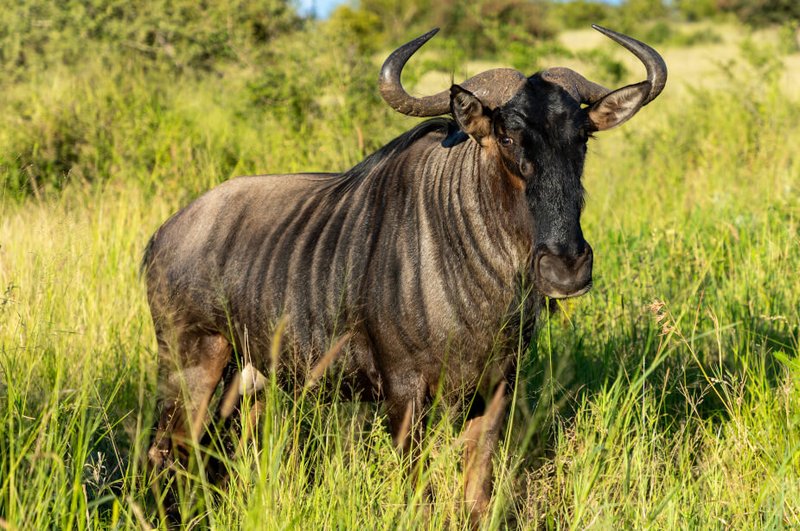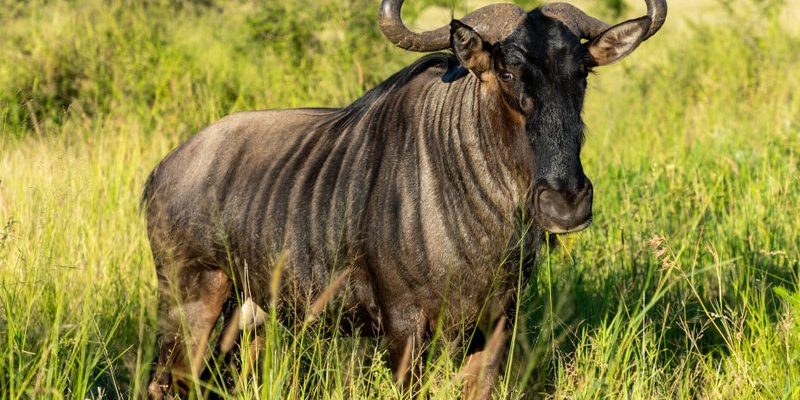
Imagine being a gnu surrounded by lush grasses and other herbaceous plants, your main source of food. Just like humans might enjoy a favorite meal, the gnu has its preferences too. They’re not just mindlessly grazing; they have their routines and strategies for finding food while keeping an eye out for dangers. These strategies are as fascinating as they are necessary for survival.
What Do Gnues Eat?
Gnus are primarily herbivores, which means their diet consists mainly of plants. Their favorite foods include grasses, especially the tender, nutritious shoots that spring up after rains. Here’s a closer look at their diet:
- Grasses: Gnus graze on a variety of grasses, including species like variety of species and bluegrass. During the rainy season, they particularly seek out the young and nutritious shoots.
- Leaves and Shrubs: When grass is scarce, they might munch on leaves from shrubs and trees, ensuring they can adapt their diet to the seasonal changes in their habitat.
- Water Sources: Gnus often move to areas near waterholes, as staying hydrated is crucial for their survival. They tend to visit these spots regularly, especially in hot weather.
Now, you might be wondering how they manage to find food in such vast landscapes. Well, it’s all about their adaptability and the way they move in herds, constantly searching for green patches.
Herd Behavior and Its Role in Foraging
One of the most captivating aspects of gnu behavior is their strong herd mentality. This social structure plays a significant role in their diet and survival strategies. Think of it as a large family unit where everyone contributes to keeping the group safe while feeding.
Gnu herds can range from a few hundred to thousands of individuals. Here’s how this herd dynamic helps them forage:
- Safety in Numbers: When feeding in a group, the risk of an individual being targeted by predators decreases. With many eyes looking out for danger, they can graze with a bit more confidence.
- Shared Knowledge: Experienced gnus often lead the way to areas with abundant food sources. Younger members learn from these patterns, enhancing the herd’s overall foraging success.
- Coordinated Movement: Herds move in a coordinated manner, making it easier to cover vast distances in search of food and water. It’s like a well-organized hiking group, ensuring everyone gets what they need.
This cooperative foraging strategy not only helps them find food but also strengthens their social bonds, which is essential for the gnu’s overall well-being.
Understanding Predators and Evasion Tactics
While gnus have a stable diet, they must also contend with a variety of predators, including lions, hyenas, and crocodiles. Here’s where their hunting strategies—or rather, evasion tactics—come into play. It’s a constant game of survival, much like a high-stakes chess match.
Gnus have developed several effective strategies to stay one step ahead of predators:
- Constant Movement: Gnues are migratory animals. They cover large distances in search of food and water, making it difficult for predators to track them over time.
- Alertness: Their keen sense of sight and hearing allows them to detect predators from afar. They often pause while grazing to scan their surroundings, maintaining a vigilant lookout.
- Group Defense: In the face of danger, gnus will band together, often making a loud noise and creating confusion to deter attackers. It’s like a protective circle where they can keep each other safe.
These tactics keep them safe while they focus on their main task: foraging for food.
The Role of Seasonality in Diet and Hunting Behavior
Just like our diets can change with seasons, gnu diets shift based on the time of year. Their hunting and foraging strategies are closely tied to the availability of resources, which affects their migration patterns.
During the rainy season, grasslands bloom with nutritious grasses, allowing gnu herds to feast. In contrast, during the dry season, food becomes scarce, prompting them to move south in search of sustenance. This seasonal migration is a classic example of nature’s rhythm. Here’s how seasonality influences their behavior:
- Migration Patterns: Gnues undertake impressive migrations, often traveling hundreds of miles to reach greener pastures. This journey is not just instinct; it’s a learned behavior that passes through generations.
- Adaptive Foraging: In dry months, gnu diets contain more woody plants and shrubs. They adapt by shifting their foraging behavior, learning which plants can sustain them during tough times.
- Water Sources: The search for water becomes critical during dry spells. Gnus know where to find these resources, and they time their movements to align with the seasonal rains.
Seasonality shapes the lives of gnus, guiding their actions and decisions in a dance with nature.
Interactions with Other Species
The gnu is not just a solo player in its ecosystem; it interacts with various other species, and these interactions can also affect its diet and hunting strategies. From symbiotic relationships to competition, the gnu’s world is bustling with connections.
For example, gnus often graze alongside zebras. They have a unique relationship that benefits both species:
- Foraging Together: Zebras and gnus can often be found grazing side by side. While gnus prefer to eat shorter grasses, zebras tend to munch on taller ones. This way, they reduce competition for food.
- Mutual Vigilance: Zebras have excellent vision, while gnus may have better hearing. This combination allows both species to watch out for predators more effectively, enhancing their chances of survival.
- Changing Environments: As they migrate, gnus also influence other species’ movements, impacting the overall ecosystem and balance of their habitat.
This interconnectedness shows how the gnu’s survival strategies are intricately tied to the existence of other animals around them.
The gnu is more than just a grazing animal. Its diet and hunting strategies reflect a complex web of relationships in its environment. From their migratory patterns to their cooperative grazing habits, gnus have adapted to survive in the wild.
By understanding their behaviors and interactions, we gain insight into the broader ecosystem. Gnus remind us of the intricate balance of life, where every creature plays a role. Their survival depends not just on what they eat, but also on their ability to adapt and work together, navigating the vast savannahs of Africa.
So next time you think about gnus, remember: they’re not just wandering around aimlessly. They’re on a constant quest for food, safety, and survival—a true testament to the resilience of nature.

